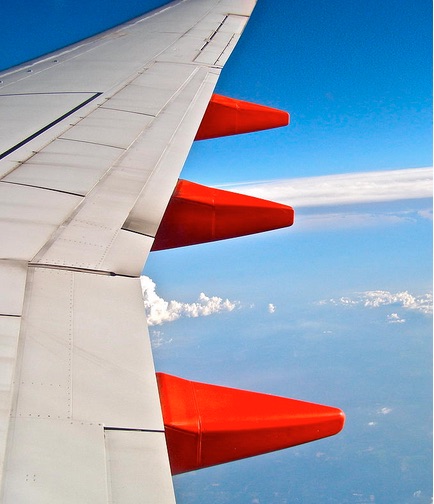
In 2002 I was a passenger on flight 606 into San Francisco. It was an usually turbulent re-entry.
If you have ever flown into San Francisco, then you know that from 10,000 feet up, it appears as if the landing strip at the airport falls off into the ocean.
We broke through the clouds, and I tightened my lap belt just to the point of not being able to breathe. White knuckled and gripping onto the arm rest, I pressed my forehead against the cold window as we made our disturbing descent. Looking out the window gave me a comforting sense of control. In my irrational mind, I thought “Well at least I know what’s coming…the Pacific Ocean!”
The closer we came to the ground, the tighter my grip became on the arm rest…on my control…on my reality…and on my anxiety.
A Hindu man sat in the seat next to me. My eyes ping-ponged between his calm demeanor and the window—our impending doom. The man had his eyes closed, head gently laid back on the head rest and the corners of his mouth slightly turned up. He was so calm, smiling almost.
I managed to muster a shaky question, “Aren’t you afraid to fly?”
He responded as he chuckled and said, calmly, “You are not afraid to fly. It is death that you afraid of…”
I don’t remember what happened after that moment. Everything went silent. Years of my fears bubbled to the surface and my mind raced like a rolodex, through the list of irrational fears. Fears that may have prevented me from greater happiness and personal freedom.
I don’t remember past that point, but we did land, because I am here telling this story.
This was my pinnacle moment. As soon as my feet touched the ground in San Francisco, I made a conscious choice and personal mission to learn why and how to rationally face my fears. I made a personal choice to live my most passionate and happy life.
We never know how we will affect each person when we meet them. That man changed my life with one sentence. I have spent the last 15 years taking the opportunity to introspectively look at myself and apply the theories of studied meditational practices, Tantra theory, and more. I insist on not allowing my learned social constructs and preconceived notions that have created my reality to hold me back from living my best life.
Here are four of my most helpful tips that help me rationalize my fear of flying.
1) Be Present:
Unfortunately, we are so removed from the process of flying that I feel that it takes an enormous amount of trust to get on the plane. We buy our ticket online, get to the airport on time, follow the herd as we shuffle through security lines. We use our phones as boarding passes, we do not even get to physically handle our tickets, we are ushered onto the plane and sit down.
I have found that being present helps me to reduce my anxiety. It helps to retrain my thinking patterns from past- and future-focused to present moment focused. Take the time to notice the sounds around you, allow them to wash over you. Letting go of the sounds that have just passed by and be present to the sound that will arise. Be mindful to your bodily sensations, feel your clothes against your skin, the way your breathing sounds as you inhale and exhale, the fluttering of your stomach, your feet against the ground. Watch how these sensations change and shift and with every exhale allow yourself to let go over them. And, finally, take notice of your thoughts. I once had a meditation teacher who said, “clearing the mind of thoughts is like training a puppy,” we have to continuously retrieve each thought to allow them to float out of the mind as easily as they float in.
Let go of future and past thoughts, and be in the now.
2) Understand the process:
The two-minute rule: Harry Houdini held his breath for four minutes while submerged under water, the typical pop song is three minutes, and the first and last two minutes of a flight are statistically the most dangerous. It is also within these first and last few minutes that the plane tends to make the most noise. The hydraulic landing gear system squeals and the engines roar in take off or landing. I have found these are the noises that are the most disturbing.
I find that it helps to put in my ear phones, turn on a song that makes me happy, one that spans the length of 120 seconds. I turn up the volume, close my eyes and pray. I have a mantra that I say 108 times. It usually takes me about 120 seconds to get all the way around my Mala strand. Once I get past that first 120 seconds, it’s generally smooth sailing and I can start to relax.
Bodhisattvas:
Bodhisattvas are traditionally someone who appears in one’s life to help them attain enlightenment. In my case, I was seeking knowledge to rationalize my fear of flying. This is the second time I believe I have been graced with a Bodhisattva. Or maybe I just got lucky. Either way, I was flying across the country and as my luck would serve me, I sat next to the Director of Commercial Pilot Training. We struck up a conversation and he gave me permission to ask him anything I wanted to know about flying. I jumped at the opportunity.
No first class for me!
My first obvious question was why, if he worked for the airlines, was he riding in coach? He answered that because of the structure of planes, the most turbulence will happen in the very front and the very back of the plane. If turbulence is your “trigger,” if you are easily frightened or have a queasy stomach, find a seat on or near the wing. You will feel much less turbulence then in the rest of the plane.
Bumpy roads:
Me: “Explain turbulence to me?”
Expert: “It’s like accidentally veering off to the side of the road. Sometimes there are bumps.”
Me: “Can these bumps ever drop us out of the sky?”
Expert: “No.”
Me: “Why does the cabin drop in pressure?”
Expert: “It can be many reasons, but a true drop in pressure rarely happens. It may feel like we drop a lot, but trust me, we do not.”
Me: “What happens if the airplane gets struck by lightening?”
Expert: “I’ve been in airplanes before that have been struck. As long as it doesn’t take out the electrical system we will be fine.”
Me: “If both engines fail, can we glide to safety?”
Expert: He chuckles, “Not from 35,000 feet up.”
Me: “What if two planes are too close to each other, will they crash into each other?”
Expert: “This is why airplanes are run by computers. If two planes are too close to each other, their computers will talk to each other, make a tactical decision, one will go up and one will go down.”
Me: “What is the most dangerous part of a flight?”
Expert: “Take off and landing, because they are done by humans. The rest is all computers.”
Me: “What happens if the computer crash?”
Expert: “These are multi-billion dollar machines. They do not let the computer ‘crash.'”
Me: “When you fly as a passenger, what planes do you fly?”
Expert: “Like cars. Newer is better. 737’s are the oldest. I don’t fly them.”
Always know your exits!
I like to consider myself a prepper when it comes to traveling. I like to be prepared for any situation. Knock on wood, I have never been in an emergency landing, but I always sit where I have a clear view and path to the emergency exits. I like to mentally map out what and who I will have to get around to get out that door to safety. There is no harm in having a plan. The trick is not to dwell on it. Know it and let it go.
3) Relax and Say your Mantra:
Unless you are certified to fly your own personal plane, then there is really no way for you to assist in the process of flying. So, instead of creating and dwelling within unnecessary anxiety, it is best to simply let go and relax. Breathe, read, watch a movie, sleep, write—I get my best articles written on planes. No distractions. I am bound to a chair for this amount of time. So I write!
And, finally, repeat your mantra. I was fortunate enough visit Amma, The Hugging Saint, a few years ago. After waiting in line until 6 a.m. for Darshan, I received my mantra. From her lips to my ears, she whispered it to me. It is a tool one can repeat whenever a task is being performed that does not require a lot of concentration. Mantras are used to keep one’s mind clear of repetitive thinking. A mantra can create a blanket of good energy over your body. It can be anything that is positive and tailored to you and your situation. Here are some examples and I am always available for consultations if you are in need of assistance:
“I am completely safe. I am loved. I am relaxed,” or a very simple one that is repeated often in yoga “I am (So Hum).”
Whatever your mantra is, say it over and over again until your mind releases whatever constructed realities it is holding on to.
4) Meditate:
Close your eyes.
Breathe through your nose.
Follow the breath from the tip of your nose, on an inhale, to the center of eyebrows,
And from the center of your eyebrows, on an exhale, to the tip of your nose.
Take a deep breath in. Expand your lungs. Keep sipping in breath.
With control, exhale. Do this three times. Release all fears with each exhale.
My best advice is that life is too beautiful not to travel and see the world. Do what you must to remove the constructs that are holding you back. Breathe, have faith, let go and say yes to every opportunity that comes your way. Face your fears head on and float within the possibility of letting go of what is not serving us. Learn to live your most passionate life and the world will open up to you, when you are ready to receive it.
Sit back and enjoy the ride.
Author: LeLa Becker
Image: Courtesy of Author
Editor: Emily Bartran






Read 27 comments and reply